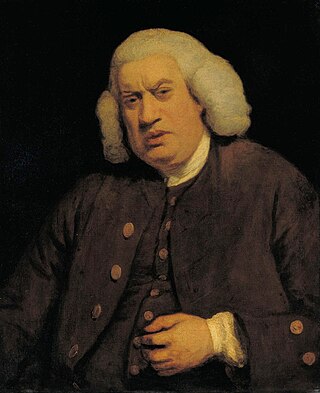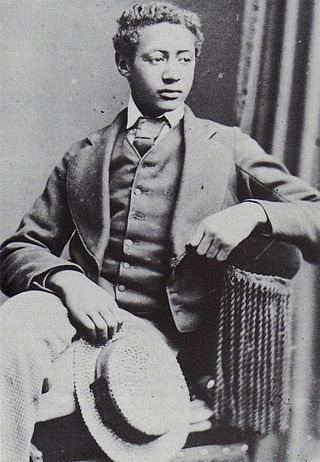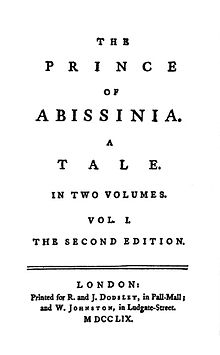
Candide, ou l'Optimisme is a French satire written by Voltaire, a philosopher of the Age of Enlightenment, first published in 1759. The novella has been widely translated, with English versions titled Candide: or, All for the Best (1759); Candide: or, The Optimist (1762); and Candide: Optimism (1947). It begins with a young man, Candide, who is living a sheltered life in an Edenic paradise and being indoctrinated with Leibnizian optimism by his mentor, Professor Pangloss. The work describes the abrupt cessation of this lifestyle, followed by Candide's slow and painful disillusionment as he witnesses and experiences great hardships in the world. Voltaire concludes Candide with, if not rejecting Leibnizian optimism outright, advocating a deeply practical precept, "we must cultivate our garden", in lieu of the Leibnizian mantra of Pangloss, "all is for the best" in the "best of all possible worlds".

Samuel Johnson, often called Dr Johnson, was an English writer who made lasting contributions as a poet, playwright, essayist, moralist, literary critic, sermonist, biographer, editor, and lexicographer. The Oxford Dictionary of National Biography calls him "arguably the most distinguished man of letters in English history".
This article contains information about the literary events and publications of 1759.

The emperor of Ethiopia, also known as the Atse, was the hereditary ruler of the Ethiopian Empire, from at least the 13th century until the abolition of the monarchy in 1975. The emperor was the head of state and head of government, with ultimate executive, judicial and legislative power in that country. A National Geographic article from 1965 called imperial Ethiopia "nominally a constitutional monarchy; in fact [it was] a benevolent autocracy".
Happy Valley may refer to:
In typography and handwriting, a descender is the portion of a letter that extends below the baseline of a font.

Candide is an operetta with music composed by Leonard Bernstein and lyrics primarily by Richard Wilbur, based on the 1759 novella of the same name by Voltaire. The operetta was first performed in 1956 with a libretto by Lillian Hellman, but since 1974 it has been generally performed with a book by Hugh Wheeler, which is more faithful to Voltaire's novella. The primary lyricist was the poet Richard Wilbur. Other contributors to the text were John Latouche, Dorothy Parker, Lillian Hellman, Stephen Sondheim, John Mauceri, John Wells, and Bernstein himself. Maurice Peress and Hershy Kay contributed orchestrations. Although unsuccessful at its premiere, Candide has overcome the unenthusiastic reaction of early audiences and critics, and achieved more popularity.

Wehni is the name of one of the mountains of Ethiopia where most of the male heirs to the Emperor of Ethiopia were interned, usually for life. It was the last of the three such mountains, or amba, said to have been used for that purpose, the other two being Debre Damo and Amba Geshen.

Amba Geshen is the name of a mountain in northern Ethiopia. It is in Ambassel, South Wollo Zone of the Amhara Region, northwest of Dessie, at a latitude and a longitude of 11°31′N39°21′E. Part of Ambassel woreda, Amba Geshen is one of the mountains of Ethiopia where most of the male heirs to the Emperor of Ethiopia were interned, usually for life. Also known as Gishen Mariam, it was the second of the three such mountains, or amba, said to have been used for this purpose, the other two being Debre Damo and Wehni.
Nagasi Krestos was the ruling prince of Shewa, an important Amhara noble of Ethiopia. Nagasi succeeded to unite fragmented Amhara districts in Shewa, and launched several wars of reconquest of Shewan territories against his Oromo enemies.

Blatten Geta Heruy Welde Sellase was an Ethiopian diplomat who was Foreign Minister of Ethiopia from 1930 to 1936 and a writer in Amharic. Bahru Zewde observes that his career "stands out as the great success story ... of the early twentieth-century intellectuals," then continues, "His prolific literary record, his influence with Tafari-Hayla-Sellase and his ascent in the bureaucratic hierarchy were all characterized by an unchequered progression. Edward Ullendorff concurs in this evaluation, describing his oeuvre as "a considerable and distinguished literary output."
Events from the year 1759 in Great Britain. This year was dubbed an "Annus Mirabilis" due to a succession of military victories in the Seven Years' War against French-led opponents.

DejazmatchAlemayehu Simyen Tewodoros, was the son of Emperor Tewodros II and Empress Tiruwork Wube of Ethiopia.

The "Poème sur le désastre de Lisbonne" is a poem in French composed by Voltaire as a response to the 1755 Lisbon earthquake. It is widely regarded as an introduction to Voltaire's 1759 acclaimed novel Candide and his view on the problem of evil. The 180-line poem was composed in December 1755 and published in 1756. It is considered one of the most savage literary attacks on optimism.
William Rider was an English historian, priest and writer. Whilst he wrote a number of works, his New Universal Dictionary suffered in comparison with that written by Samuel Johnson and his 50-volume work A New History of England was unsuccessful; it was later described as one of the vilest Grub Street compilations ever published. He was a chaplain and master at St Paul's School for many years, as well as being associated with the Mercers' Company and churches in the City of London.
Robert William Chapman, usually known in print as R. W. Chapman, was a British scholar, book collector and editor of the works of Samuel Johnson and Jane Austen.
Inés Joyes y Blake was a Spanish translator and writer of the Age of Enlightenment. She became known in the field of letters with her translation of the novel The History of Rasselas, Prince of Abissinia by Samuel Johnson. Her edition of this work includes a text of her own, entitled "Apología de las mujeres", which constitutes one of the first feminist essays in Spain.

Roy Wolper is an American scholar and writer. A full-time professor at Temple University from 1967 to 1998, and a writer of fiction, he co-founded The Scriblerian and the Kit-Cats, a review journal for English literature, and served as its editor for nearly fifty years.

Rusher's Patent Types were the characters of an experimental serif typeface invented, patented and promoted by Philip Rusher in Banbury, England, from 1802 onwards. The typeface removed the descenders from the lower-case letters and shortened the ascenders, which Rusher hoped would make the typeface "more uniform" and save paper. The typeface was used for a few books but did not become popular.
The 1922 regnal list of Ethiopia is an official regnal list used by the Ethiopian monarchy which names over 300 monarchs across six millennia. The list is partially inspired by older Ethiopian regnal lists and chronicles, but is notable for additional monarchs who ruled Nubia, which was known as Aethiopia in ancient times. Also included are various figures from Greek mythology and the Biblical canon who were known to be "Aethiopian", as well as figures who originated from Egyptian sources.












